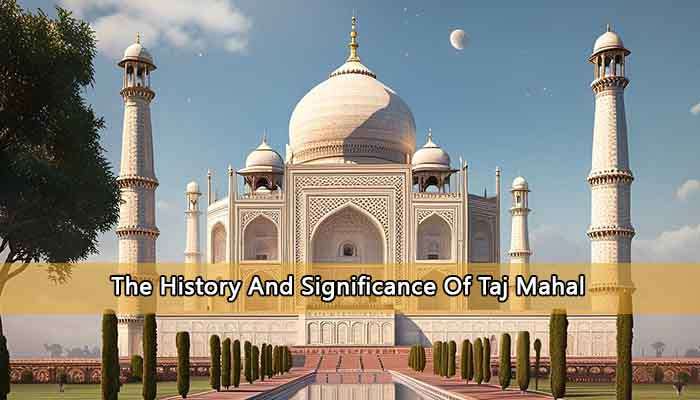
Taj Mahal: The History And Significance
Introduction
The Taj Mahal, an architectural masterpiece, stands as a testament to the eternal love of Mughal Emperor Shah Jahan for his wife Mumtaz Mahal. Located on the banks of the Yamuna River in Agra, Uttar Pradesh, the Taj Mahal is a symbol of India’s rich history and cultural heritage. Its outstanding universal value has earned it the status of a UNESCO World Heritage Site. In this article, we will explore the history, significance, and unique features of the Taj Mahal, as well as its ongoing preservation efforts.
A Love Story Carved in Marble: Taj Mahal
The Taj Mahal’s construction was finished in 1648 AD, having started in 1632 AD. The talented architect Ustad-Ahmad Lahori played a key role in bringing Emperor Shah Jahan’s vision to life. The Taj Mahal was meticulously crafted by skilled artisans and craftsmen who were brought in from different parts of the Mughal Empire, as well as Central Asia and Iran.
Architectural Beauty and Aesthetic Brilliance
The Taj Mahal is renowned for its architectural beauty and aesthetic brilliance. It seamlessly blends elements of Indo-Islamic and Persian architectural styles, creating a harmonious symphony of design. The monument’s symmetrical layout, with its perfect balance of solids and voids, creates a sense of visual harmony. The use of arches, domes, and intricate carvings adds depth and dimension to the structure.
The Magnificent Structure
The Taj Mahal is situated within a sprawling Mughal garden spanning approximately 17 hectares. The garden itself is a marvel of horticultural planning, with lush green lawns, meandering pathways, and vibrant flowerbeds. The tomb, located at one end of the garden, is a raised structure that commands attention. Four minarets stand tall at the corners of the platform, providing a three-dimensional effect to the monument.
The Marvels Within
As one enters the Taj Mahal complex through the grand main gate, they are greeted by a mesmerizing sight. The main building, constructed primarily of red sandstone and marble, houses the tomb of Mumtaz Mahal and Shah Jahan. The cenotaphs, intricately adorned with precious and semi-precious stones, evoke a sense of awe and reverence. The marble lattice screens surrounding the cenotaphs showcase the exceptional craftsmanship of the artisans.
Preservation Efforts and Challenges
The Taj Mahal has withstood the test of time, but its preservation requires ongoing efforts. The Archaeological Survey of India (ASI) is responsible for the management and protection of the monument. To combat the impact of atmospheric pollutants, an air control monitoring station has been installed to ensure the air quality remains optimal. Additionally, a buffer zone of 10,400 sq km has been designated to protect the Taj Mahal from pollution.
Ensuring Authenticity and Integrity
Preserving the authenticity and integrity of the Taj Mahal is of paramount importance. While repairs and conservation work have been undertaken, they have been carried out in a manner that preserves the original qualities of the monument. Guidelines are in place to ensure that future conservation work adheres to these principles.
A Timeless Wonder
The Taj Mahal continues to captivate visitors from around the world with its timeless beauty. Its architectural grandeur, exquisite craftsmanship, and rich historical significance make it a must-visit destination. The monument’s universal value has earned it a place on the list of Seven Wonders of the World, further cementing its status as an iconic symbol of love and devotion.
Conclusion
The Taj Mahal stands as an enduring testament to the love and craftsmanship of the Mughal era. Its architectural brilliance, aesthetic beauty, and cultural significance make it a jewel in India’s crown. Efforts to preserve and protect this magnificent monument ensure that future generations can marvel at its grandeur and appreciate its historical and artistic value. The Taj-Mahal truly is a timeless wonder that continues to inspire awe in all who behold it.
Additional Information: The Taj-Mahal can be viewed from space due to its monumental size and distinctive white marble structure. Satellite images of the Taj-Mahal provide a unique perspective on this architectural marvel and also read more on wikipedia




